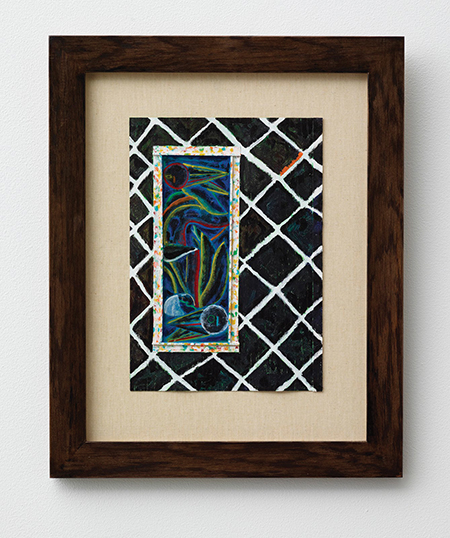In Focus: Alexander Tovborg
From clairvoyance to religiosity and the secret of the ‘100 Black Planets’
From clairvoyance to religiosity and the secret of the ‘100 Black Planets’

If contemporary art seldom concerns itself with religious (as opposed to fuzzily spiritual) life, then the work of Alexander Tovborg might be understood as an attempt at restitution. Significantly, the Danish artist’s interest in religiosity does not lie primarily in its political expression, nor is it coldly anthropological or about finding cosmetic charm in the contours of any one faith’s observances or creed. Rather, in his paintings, drawings, prints, occasional sculptures and (perhaps most vividly) the conduct of his artistic practice, Tovborg explores the central role that religion might play in how our species imagines itself, and the seen and unseen worlds it inhabits. To dismiss this as archaic is to forget that religious life remains the global norm: a 2010 study estimated that only two percent of our planet’s human population is atheist.
Tovborg first began to attend daily Mass in Copenhagen in 2008, during his final year of studies at the Royal Danish Academy of Fine Arts. Since then, he has involved himself in a number of Christian congregations, from Catholic and Baptist groups to a chapter of Sri Lankan White Tiger Apostles. He has also created a series of self-portrait masks with a Hindu stonecarver in Kerala, India, trained as an apprentice to a Japanese tea master, and participated in Cuban Santería rituals. (When I last saw him, he was wearing an amulet given to him by a Vodou priest, which rested on his floral shirt like a 1980s rapper’s chain.) Earlier this year, Tovborg completed a year-long stint as guest editor of Ribe Domkirkes Nye Kirkeblad, the parish magazine of Denmark’s oldest church, during which time he published contributions from clergy, artists, music bloggers, medievalists, poets, astrophysicists and a friend who recounted an LSD trip. Tovborg is now working with a clairvoyant to explore his past lives, and has a meeting scheduled with a 17th-generation Marabout mystic, from whom he hopes to learn the secret of the ‘100 Black Planets’.

Any suspicion of cultural or spiritual tourism these pursuits might engender is offset by the artist’s sincerity, and his appetite for hard and often unglamorous work; there’s little about his practice that could be confused with spending a few days at a five-star yoga retreat. We might imagine Tovborg as an eternal initiate, content to patiently play the role of ‘young grasshopper’ in his own lifelong production of The Karate Kid (1984).
For ‘Giverny’, his 2012 solo show at Brand New Gallery in Milan, Tovborg re-imagined the Biblical Eden as Claude Monet’s famous garden at Giverny, and Adam and Eve as two day-trippers who, their eyes meeting in the ticket line, feel suddenly compelled to exhaust every position in the Kama Sutra against the backdrop of the garden’s iconic lily pads and arcing Japanese bridge. Tovborg’s resulting canvases and lino-cuts reference both Indian erotic miniatures and a kind of hallucinogenic Impressionism, in which all that materialist business about natural light appears to have been jettisoned in favour of representing the interior illumination provided by a divine creator, or simply by incredible sex. At once explicit, joyful and very funny (Tovborg is keenly aware of how absurdly bourgeois this fantasy scenario is), works such as Tourist (By the water lilies) and Tourist (In the garden lake) (both 2011) profane the artistic and spiritual traditions they draw on, while investing them with a new and lively sacredness.

Invited by the Hospitalhof Stuttgart in Germany to create a body of work for the city’s protestant chapel, the Brenzkirche, in the autumn of 2012, Tovborg responded with 21 framed, partially collaged paintings depicting imagined and often heavily abstracted scenes from Christ’s ‘lost’ adolescence and young manhood. (The canonical Bible does not record Christ’s life between his twelfth birthday and the beginning of his ministry at the age of 30, although various apocryphal Christian texts and Hindu Puranas suggest he took an extended ‘gap year’ in India, where he was influenced by Eastern thought.) Each entitled Teenage Jesus (2012), Tovborg’s paintings employ the notion of the frame – physical, intellectual, spiritual – to compose a counter-Gospel. That he hung these atop a giant graffiti tag he painted directly onto the chapel’s wall, featuring a portrait of the Messiah as a grinning, baseball-capped, peace-sign-flashing dude, is testament not only to his ability to laugh at himself, but to his hosts. Tovborg is now planning a series of works about the Jurassic era – a period before the Earth played home to a human consciousness, and so before it played home to an idea of God. I wonder how faith (and faithlessness) look when viewed from the dinosaur swamps.
Alexander Tovborg is an artist based in Copenhagen, Denmark, and Berlin, Germany. His work was recently included in the group shows ‘I knOw yoU’ at the Irish Museum of Modern Art, Dublin, Ireland, and ‘The World is Almost Six Thousand Years Old’, various venues, Lincoln, UK, which was curated by the author.

























